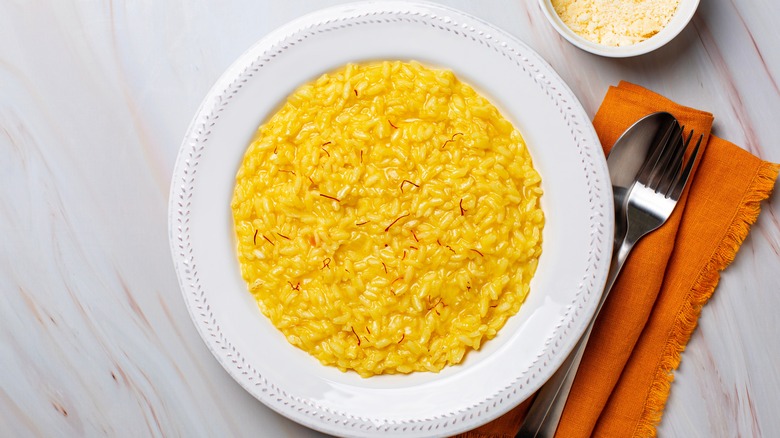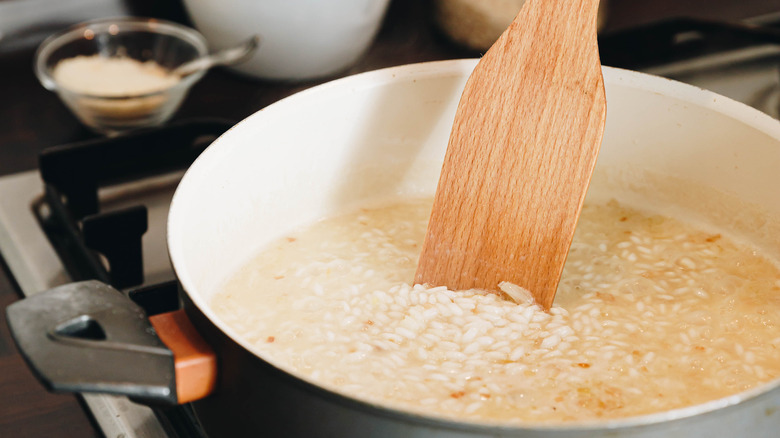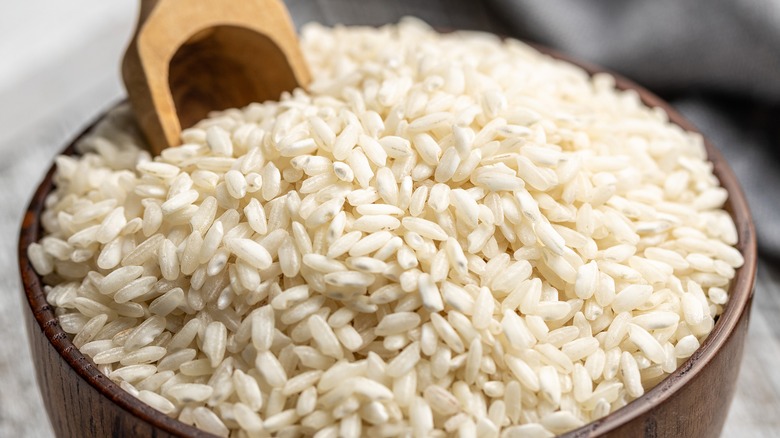How Much You Can Stir Risotto Without Ruining It
Risotto is an Italian dish that hails from the northernmost regions of the country, specifically Piedmont and Lombardy, where the milanese preparation with its vibrant colors and flavors of saffron got its claim to fame. But, you don't have to travel overseas to enjoy it. The classic Italian dish can be made easily and inexpensively anywhere in the world.
In fact, a basic risotto recipe only calls for a handful of ingredients that you may already have on hand: rice, white wine, an onion, vegetable broth, salt, butter, and cheese. Even better, the whole meal is made in a single large pot. But, because of the simplicity of the recipe, the technique is super important and there is one part of the risotto-making process that matters above all: how you stir it.
The first steps are simple — the onion is cooked in butter in a pot on the stovetop, then the rice is added, followed by wine. Next, broth is poured in slowly, adding just a cup at a time, while the rice cooks. This takes about 15 to 30 minutes. How often you stir risotto while it cooks affects the creamy consistency of the final dish, so you want to do so carefully, and the trick is not to overdo it. Rather than incessantly stirring, use a large spoon to slowly move the rice around every 30 seconds or so, just enough to make sure it does not form a crust on the bottom of the pot.
Why your stirring method matters
Italians break down the process of making risotto into four main steps: tostatura, sfumatura, cottura, and mantecatura. Roughly translated, these steps are: toasting, smoking, cooking, and resting. In the first, the rice is toasted, then alcohol (usually white wine) is added and smoked (or burned off) as it heats in the pan.
Once the rice has fully cooked, cheese and butter are stirred in during the final resting phase, adding to the rich creaminess of the dish. Each stage is important in its own way, but it is the third phase — in which the stirring of the rice takes place — that most defines the consistency of the dish.
As the rice cooks, you don't need to break a sweat standing at the stove constantly stirring. Keep the pot over a medium heat so that the rice and broth mixture gently bubbles and stir it every now and then, in between other tasks like grating cheese or cleaning up. This ensures that all of the rice kernels are a consistent texture, so that you don't end up with some that are crispy while others are mushy.
Tips and tricks for creamy risotto
There is an even more hands-off way to cook risotto if you hate stirring that relies on the use of a slow-cooker to gently warm and soften the rice as it cooks, unifying the dish with more time and less effort. For the best results, however, some stirring will help the broth absorb into the rice kernels as starch is released. This is what creates the rich and creamy texture that defines the dish. As the risotto nears the end of its cooking time, it is important to test it every few minutes to check that it does not become too soft.
Besides stirring, the other most important element that will affect the risotto is the type of rice that you use. Arborio is often seen on the ingredient list in a risotto recipe, but another rice variety, carnaroli, is even better. It is a medium-grain with high starch content that adds creaminess to the overall dish, while the individual kernels maintain a pleasantly firm and chewy al dente texture.



